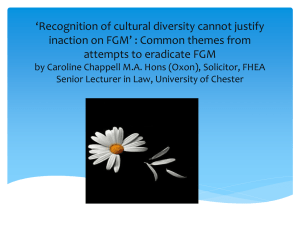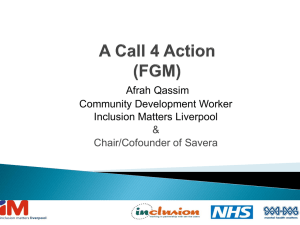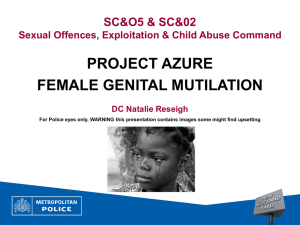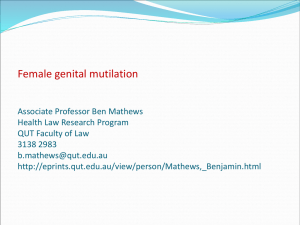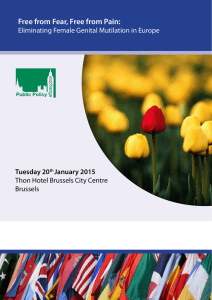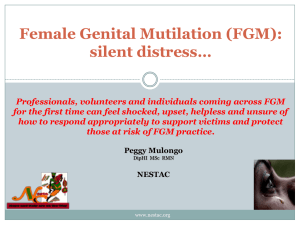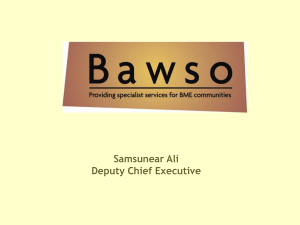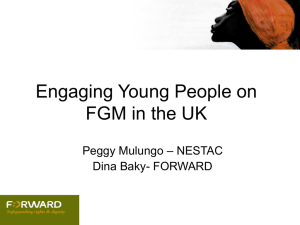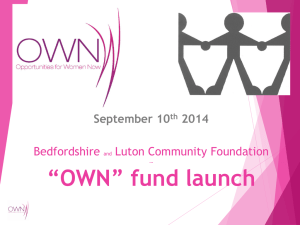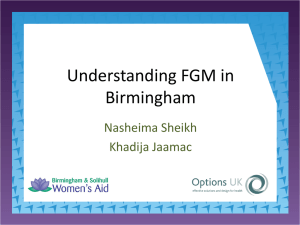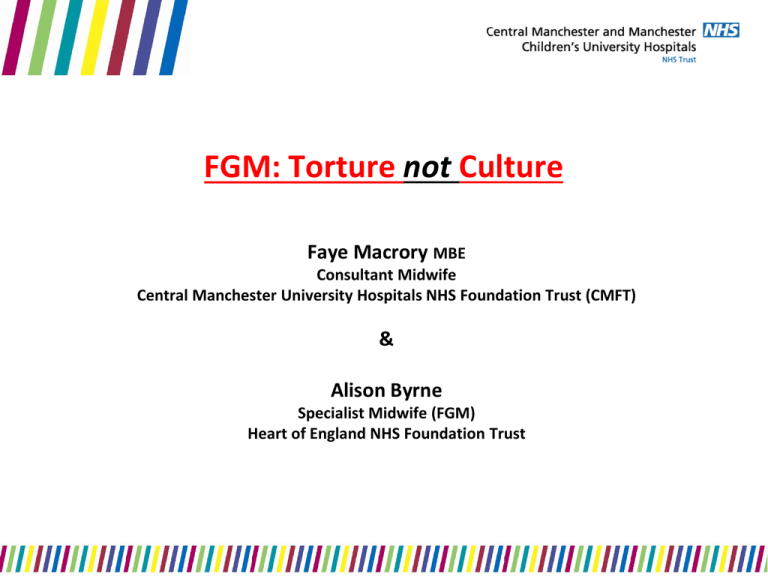
FGM: Torture not Culture
Faye Macrory MBE
Consultant Midwife
Central Manchester University Hospitals NHS Foundation Trust (CMFT)
&
Alison Byrne
Specialist Midwife (FGM)
Heart of England NHS Foundation Trust
the starting point……………
FGM is the manifestation of gender
inequality that is entrenched in social,
economic and political structures.
FGM is a form of violence against
women and girls.
(WHO 2008)
The FGM Act (2003)
It is an offence to excise, infibulate or otherwise
mutilate the whole or any part of the labia majora,
labia minora or clitoris of another person for non
medical reasons, or to aid, abet council or procure
any of these acts on that person’s own body.
It is also an offence to take a child out of the Uk for
that purpose or to arrange it.
The penalty is up to 14 years imprisonment.
Where FGM is practised: communities at risk
Africa:
Benin, Burkina Faso, Cameroon, Central African
Republic, Chad, Cote d’Ivoire, Dijibouti, Egypt,
Eritrea, Ethiopia, Gambia, Ghana, Guinea, GuineaBissau, Liberia, Mali, Mauritania, Niger, Nigeria,
Senegal, Sierra Leone, Somalia, Sudan, Togo,
Uganda, United Republic of Tanzania.
Also:
Iran, Iraq, Malaysia, Saudi Arabia
Classification of FGM
FGM (also called cutting) comprises all procedures that
involve partial or total removal of the external female
genitalia, or other injury to the female genital organs for
non medical reasons
(WHO 2008)
Terms used: e.g.
sunna, kakia, bundu, tara, tahur:- meaning purification
Type 1:
Clitoridectomy: partial or total removal of the clitoris
Type 2:
Excision: partial or total removal of the clitoris and the labia
minora with or without excision of the labia majora
Type 3:
Infibulation: narrowing of the vaginal opening through the
creation of a covering seal, repositioning outer and inner
labia with, or without removal of the clitoris
Type 4:
All other harmful procedures to the female
genitalia for non-medical purposes e.g.
• pricking
• piercing
• incising
• scraping
• cauterizing the genital area
?? and what about labioplasty/ cosmetic surgery??
Why the practice continues:
• custom and tradition
• mistaken belief that FGM is a religious
requirement
• preservation of virginity/chastity
• social advantage, especially for marriage
• enhancing fertility
• hygiene and cleanliness
• increasing male sexual pleasure
• family honour
• sense of belonging to a group vs fear of social
exclusion (WHO 2008)
Short term complications of FGM
•
•
•
•
•
•
•
haemorrhage
shock
acute urinary retention
damage to other organs
infection
failure to heal
death
Long term complications of FGM:
•
•
•
•
•
•
•
•
difficulties passing urine
urinary tract infection/HIV, Hep.B
menstruation difficulties
chronic pelvic infection
infertility
vulva abscess/cyst/calculus/neuroma
keloid scarring/fistula
increased risk during delivery e.g. perineal
trauma, PPH and perinatal death
• Sexual, psychological and psychosexual
difficulties
Psychological impact of FGM
• physical effects well documented but emotional effects
remain limited in the research.
• psychological counselling may lead to feelings of betrayal
by parents, incompleteness and anger, overwhelming
trauma and the long lasting emotional damage and
implications from FGM and of suffering in silence.
• psychosocial implications of NOT undergoing FGM are also
considerable. Therapeutic interventions need to take into
account deep rooted beliefs into the practice of FGM and
the cultural and social pressures women from practising
communities are likely to experience.
(Mulongo, P. et al. 2014)
NESTAC (New Step for African Community 2012)
and Support our Sisters (SOS)
• Aim to add to the body of knowledge re the emotional
effects of FGM & appropriate interventions
• 3 year collaborative research project under Salford
University Well-Being Programme
• a community based programme mainly supporting
refugees & asylum seekers and attending to their sociocultural needs
• the development of a specialized service (SOS) for
cognitive & emotional support
• 3 drop-in clinics ( Rochdale, Lower Broughton and St.
Mary’s)
• accredited training for peer mentors
Health
Health professionals have many opportunities to
identify women affected and girls at risk
particularly in:
•
•
•
•
•
•
A&E/ED
maternity and gynaecology
female surgery
urology/continence team
SARC, GUM, CASH
GPs, HVs, School Nurses
CMFT action plan
2 key aspects in managing FGM:
• provision of sensitive & appropriate services to
all women identified with FGM
• Safeguarding infants and girls at risk of FGM
3 elements:
• data collection
• education & awareness
• safeguarding
Completing the form online
• form combines 4 forms from original DH documents so
minimises repetitive data capture
• to be used for all new FGM patients
• details submitted to database - automatically amends
duplication registrations made under same case note
number
• all future contacts recorded on PAS and CMIS
automatically identified to satisfy requirement to report
on ongoing active caseloads of contacts with known FGM
patients
What did we need to do before going live?
• addition of instruction sheet to data collection form,
including SARC & GUM
• agree when & how information is shared with
Safeguarding
• implement a sign-off and assurance process before
monthly data is shared externally
• add link to Intranet for easy access to online form
• communicate with staff and raise awareness e.g. via
WWN
Safeguarding Guidance
• identifying risks
• pathways
• response from CS
• sensitivities and complexities of FGM
What’s going on…….?
• community based prevention – what works?
• multi-agency collaboration
• nationally
• internationally
CASE STUDY 1
• A woman presents needing a
vaginal/speculum examination and is
found to have FGM. She is extremely
distressed during the examination.
What should you do?
CASE STUDY 2
• A pregnant woman discloses at booking
that her 1st child born in Somalia in 1997
has had FGM.
What course of action would you take?
CASE STUDY 3
• Following disclosure of FGM a woman
asks you where she can get FGM
performed in this country for her
daughters.
What will your response be?
CASE STUDY 4
• Police officers request that a child is
physically examined as there has been an
allegation that the child is at risk of FGM.
What would you do?
Useful websites
•
•
•
•
•
•
•
•
www.fgmnationalgroup.org
www.rcm.org.uk
www.who.int/
www.amnesty.org.uk
www.fgmnetwork.org
www.equalitynow.org
www.dofeve.org
www.nspcc.org.uk
•
•
•
•
•
•
www.endthefear.co.uk/practitioners
www.afruca.org
www.forwarduk.org.uk
www.nestac.org
www.fgmelearning.co.uk
http://greatermanchesterscb.proceduresonline.
com/chapters/p_fgm.html
• House of Commons, Home Affairs Committee:
FGM: the case for a a national action plan 20142015
• http://www.hscic.gov.uk/catalogue/PUB15711
FGM is child abuse
Call the NSPCC helpline
0800 028 3550
or
email: fgmhelpline@nspcc.org.uk
never forget
It’s torture……….
not culture…….
In the memory and admiration of:
Efua Dorkenoo
1949 - 2014
Cutting the Rose: FGM Practice & Prevention (1994)

